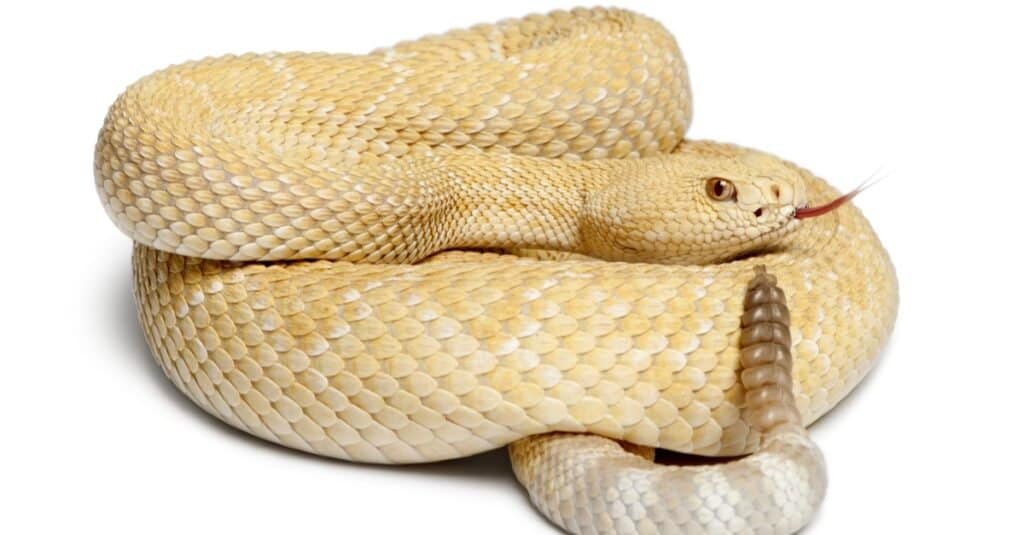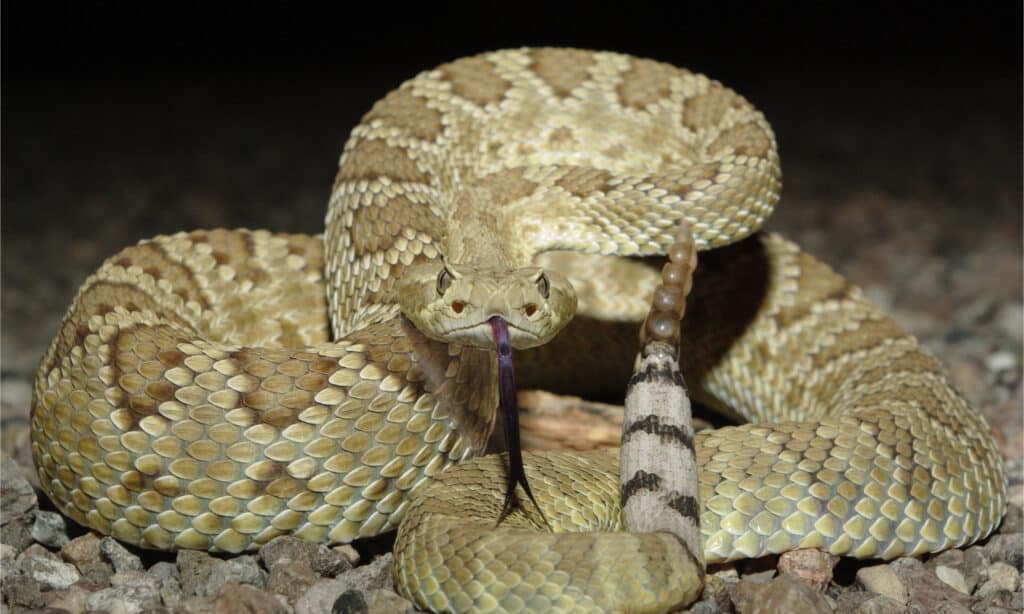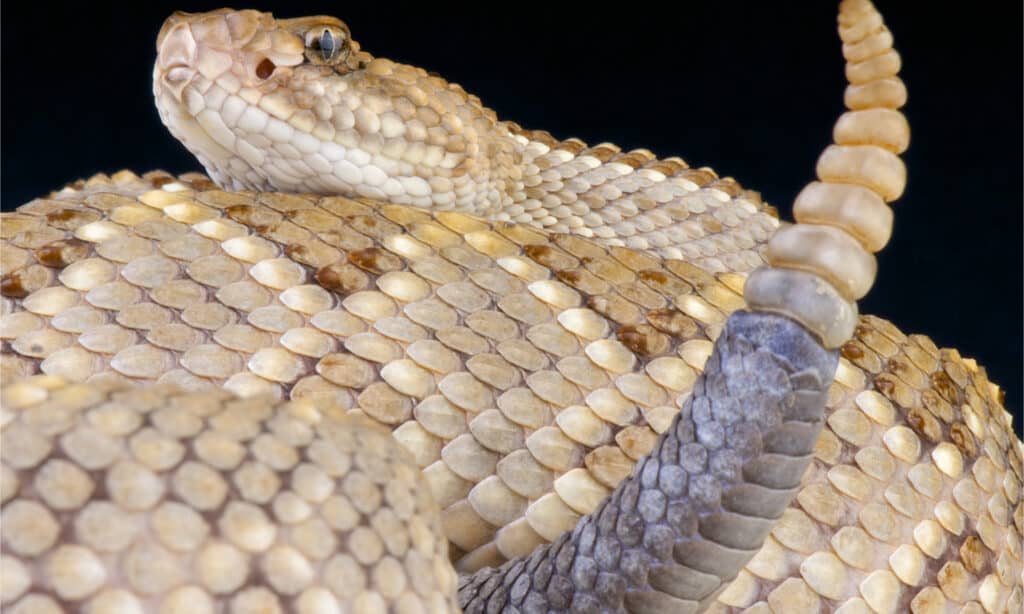Why Do Rattlesnakes Have a Rattle on Their Tails?
#mobileSnakeQuizControls { overflow: hidden; text-overflow: ellipsis; white-space: nowrap; }
@media (min-width: 481px) {
.mobile-top-content {
display: none;
}
}
#mobileTopContentCTACarouselControls { overflow: hidden; text-overflow: ellipsis; white-space: nowrap; }
.mobile-top-content .more { color: #fff; }
.mobile-top-content a { color: #fff; text-decoration: underline; }
.mobile-top-content a:hover { color: #fff; text-decoration: underline; }
@media (max-width: 480px) {
.mobile-top-content {
background-color: #06a10b;
color: #fff;
text-align: center;
/*height: 60px;
padding-top:5px;*/
font-size:80%;
/* display: block; */
margin: 0px -30px;
}
}
It’s a true fact that all rattlesnakes have a rattle on their tail. But, not all rattlesnake rattles are equal.
Rattlesnakes are members of the pit viper family, so named for the heat-sensing pits on their faces. Some of the most common species include the timber rattlesnake, prairie rattlesnake, mojave rattlesnake, eastern diamondback, and western diamondback. All species are vulnerable to predation by kingsnakes, roadrunners, coyotes, feral pigs, and birds of prey.
Like other snakes, rattlesnakes prey mostly on small creatures like mice, rats, and rabbits. In fact, if we didn’t have rattlesnakes, these small grass-eaters would quickly denude all the plants in their habitat, leaving nothing left for other herbivores like deer and antelope. Rattlesnakes, and the rattles on their tails, may be scary—but they’re much more dangerous to small mammals than they are to humans.
button.pulse {
transform: scale(1); animation: pulse 2s infinite;
box-shadow: 0 0 0 0 rgba(11, 247, 25, 1);
}
@keyframes pulse {
0% { transform: scale(0.90); box-shadow: 0 0 0 0 rgba(11, 247, 25, 0.5); }
60% { transform: scale(1); box-shadow: 0 0 0 15px rgba(11, 247, 25, 0); }
100% { transform: scale(0.90); box-shadow: 0 0 0 0 rgba(11, 247, 25, 0); }
}
Here, we’ll learn more about rattlesnake rattles, why they have them, how they use them, and what they’re made of. Then, we’ll go over the steps you should take if a rattler rattles at you, and go in-depth on why rattlesnakes are important to the environment.
Do All Rattlesnakes Have Rattles?

All 36 rattlesnake species have rattles. But, rattlesnakes aren’t born with a ready-made rattle. Baby rattlesnakes hatch from eggs while still inside their mother’s womb. Female rattlesnakes actually incubate the eggs inside their bodies, then give birth to live young. When the snakelings are born, they have only one rattle segment, not enough to make any noise with.
Within one week of life, the baby rattlers shed their skin, and gain another rattle segment. But, it’s not until they have at least three segments that they can produce the sound they’re so famous for. As rattlesnakes grow, they gain a rattle segment every time they shed their skin. But, the length of the rattle can’t be used to determine age, as the end rattle segment frequently breaks off.
What Are Rattles Made Of?
Rattlesnake rattles aren’t made of bone, or even scale. Instead, they’re made out of keratin, the same thing human fingernails are made of. Each rattle segment fits inside of the next one, but the fit isn’t perfect. Each segment is only loosely fitted to the one behind and in front of it, so that, when the rattlesnake shakes its tail, the segments actually vibrate against one another, producing the characteristic rattle sound.
Why Do Rattlesnakes Rattle?

Ali Iyoob Photography/Shutterstock.com
Rattlesnakes are the only snakes in the world that rattle their tails, but why do they do it? Well, they don’t use their rattles to hunt—rattlesnakes depend on the element of surprise to stalk and kill prey like mice and rabbits. Rather, they use their loud rattles to warn away threats, like humans, cows, coyotes, kingsnakes, and roadrunners. The rattle is the rattlesnake’s way of saying ‘hey, I have a venomous bite, and if you get too close to me, I’ll be forced to use it.’ Rattlers only rattle as a last resort, but, the ability to rattle means that more rattling snakes survive than non-rattling snakes, which is exactly why the rattlesnake has a rattle.
Occasionally, hikers run into rattlesnakes that don’t rattle at all. This can happen for a number of reasons—the person may not be close enough to warrant a rattle or the rattler may still be relying on their ability to stay hidden. Whether you see a rattlesnake or hear it, there are a few things you should do to avoid a bite.
What to Do if a Rattlesnake Rattles at You

reptiles4all/Shutterstock.com
So you’re walking along a forest path, or maybe taking in the smell of sagebrush in the desert, and you hear the rattle of a rattlesnake. What do you do?
Your first step is to freeze, don’t make any sudden movements. Listen to the sound, and, without moving, try to figure out where the snake is. Once you know where it is, slowly move away from the sound. The rattlesnake will likely keep rattling at you until you’re a good distance away. Don’t try to find the snake—most people who hear rattlesnakes never actually see them, and that’s a good thing.
If you do see the rattlesnake, take the same steps. Don’t approach it, and don’t attempt to kill it. Statistically, you’re much more likely to sustain a bite if you attack the rattlesnake than if you just leave it alone. Remember, rattlesnakes don’t want to bite you, that’s why they rattle.
Can Rattlesnakes Live Without Their Rattle?
Rattlesnakes may lose their rattles in several different ways, including injury from a predator or accidental crushing. Rattleless rattlesnakes are extremely uncommon, and most don’t live long. Without a way to let predators know that they’re dangerous, they soon fall victim to predators like kingsnakes and roadrunners.
Occasionally, people attempt to kill rattlers for their rattles. This is a bad idea for several reasons, the first of which being the danger of getting bitten. Additionally, some hikers report that rattlesnakes seem to be rattling less in recent decades, though no scientific studies have ever shown this to be true.
Why Rattlesnakes Matter
Rattlesnakes and their rattles may be terrifying, but they’re actually important parts of the environment. They keep rodent populations down. Without them, things like mice and rabbits would soon eat themselves out of house and home. Killing rattlesnakes for sport, or out of fear, not only disrupts the ecology of the region, but it also puts other kinds of animals at risk of starvation.
If small mammals eat all the food, then there’s none left for larger animals, like elk and deer. With no food, these animals cannot survive in the environment. So, rattlesnakes may seem scary, but they’re actually vital to keeping the natural world in balance.
Discover the “Monster” Snake 5X Bigger than an Anaconda
Every day A-Z Animals sends out some of the most incredible facts in the world from our free newsletter. Want to discover the 10 most beautiful snakes in the world, a “snake island” where you’re never more than 3 feet from danger, or a “monster” snake 5X larger than an anaconda? Then sign up right now and you’ll start receiving our daily newsletter absolutely free.
More from A-Z Animals
.more-snake-card-image { max-height:140px !important; }
#mobileSnakeQuizControls { overflow: hidden; text-overflow: ellipsis; white-space: nowrap; }
@media (min-width: 481px) {
.mobile-top-content {
display: none;
}
}
#mobileTopContentCTACarouselControls { overflow: hidden; text-overflow: ellipsis; white-space: nowrap; }
.mobile-top-content .more { color: #fff; }
.mobile-top-content a { color: #fff; text-decoration: underline; }
.mobile-top-content a:hover { color: #fff; text-decoration: underline; }
@media (max-width: 480px) {
.mobile-top-content {
background-color: #06a10b;
color: #fff;
text-align: center;
/*height: 60px;
padding-top:5px;*/
font-size:80%;
/* display: block; */
margin: 0px -30px;
}
}
It’s a true fact that all rattlesnakes have a rattle on their tail. But, not all rattlesnake rattles are equal.
Rattlesnakes are members of the pit viper family, so named for the heat-sensing pits on their faces. Some of the most common species include the timber rattlesnake, prairie rattlesnake, mojave rattlesnake, eastern diamondback, and western diamondback. All species are vulnerable to predation by kingsnakes, roadrunners, coyotes, feral pigs, and birds of prey.
Like other snakes, rattlesnakes prey mostly on small creatures like mice, rats, and rabbits. In fact, if we didn’t have rattlesnakes, these small grass-eaters would quickly denude all the plants in their habitat, leaving nothing left for other herbivores like deer and antelope. Rattlesnakes, and the rattles on their tails, may be scary—but they’re much more dangerous to small mammals than they are to humans.
button.pulse {
transform: scale(1); animation: pulse 2s infinite;
box-shadow: 0 0 0 0 rgba(11, 247, 25, 1);
}
@keyframes pulse {
0% { transform: scale(0.90); box-shadow: 0 0 0 0 rgba(11, 247, 25, 0.5); }
60% { transform: scale(1); box-shadow: 0 0 0 15px rgba(11, 247, 25, 0); }
100% { transform: scale(0.90); box-shadow: 0 0 0 0 rgba(11, 247, 25, 0); }
}
Here, we’ll learn more about rattlesnake rattles, why they have them, how they use them, and what they’re made of. Then, we’ll go over the steps you should take if a rattler rattles at you, and go in-depth on why rattlesnakes are important to the environment.
Do All Rattlesnakes Have Rattles?

All 36 rattlesnake species have rattles. But, rattlesnakes aren’t born with a ready-made rattle. Baby rattlesnakes hatch from eggs while still inside their mother’s womb. Female rattlesnakes actually incubate the eggs inside their bodies, then give birth to live young. When the snakelings are born, they have only one rattle segment, not enough to make any noise with.
Within one week of life, the baby rattlers shed their skin, and gain another rattle segment. But, it’s not until they have at least three segments that they can produce the sound they’re so famous for. As rattlesnakes grow, they gain a rattle segment every time they shed their skin. But, the length of the rattle can’t be used to determine age, as the end rattle segment frequently breaks off.
What Are Rattles Made Of?
Rattlesnake rattles aren’t made of bone, or even scale. Instead, they’re made out of keratin, the same thing human fingernails are made of. Each rattle segment fits inside of the next one, but the fit isn’t perfect. Each segment is only loosely fitted to the one behind and in front of it, so that, when the rattlesnake shakes its tail, the segments actually vibrate against one another, producing the characteristic rattle sound.
Why Do Rattlesnakes Rattle?

Ali Iyoob Photography/Shutterstock.com
Rattlesnakes are the only snakes in the world that rattle their tails, but why do they do it? Well, they don’t use their rattles to hunt—rattlesnakes depend on the element of surprise to stalk and kill prey like mice and rabbits. Rather, they use their loud rattles to warn away threats, like humans, cows, coyotes, kingsnakes, and roadrunners. The rattle is the rattlesnake’s way of saying ‘hey, I have a venomous bite, and if you get too close to me, I’ll be forced to use it.’ Rattlers only rattle as a last resort, but, the ability to rattle means that more rattling snakes survive than non-rattling snakes, which is exactly why the rattlesnake has a rattle.
Occasionally, hikers run into rattlesnakes that don’t rattle at all. This can happen for a number of reasons—the person may not be close enough to warrant a rattle or the rattler may still be relying on their ability to stay hidden. Whether you see a rattlesnake or hear it, there are a few things you should do to avoid a bite.
What to Do if a Rattlesnake Rattles at You

reptiles4all/Shutterstock.com
So you’re walking along a forest path, or maybe taking in the smell of sagebrush in the desert, and you hear the rattle of a rattlesnake. What do you do?
Your first step is to freeze, don’t make any sudden movements. Listen to the sound, and, without moving, try to figure out where the snake is. Once you know where it is, slowly move away from the sound. The rattlesnake will likely keep rattling at you until you’re a good distance away. Don’t try to find the snake—most people who hear rattlesnakes never actually see them, and that’s a good thing.
If you do see the rattlesnake, take the same steps. Don’t approach it, and don’t attempt to kill it. Statistically, you’re much more likely to sustain a bite if you attack the rattlesnake than if you just leave it alone. Remember, rattlesnakes don’t want to bite you, that’s why they rattle.
Can Rattlesnakes Live Without Their Rattle?
Rattlesnakes may lose their rattles in several different ways, including injury from a predator or accidental crushing. Rattleless rattlesnakes are extremely uncommon, and most don’t live long. Without a way to let predators know that they’re dangerous, they soon fall victim to predators like kingsnakes and roadrunners.
Occasionally, people attempt to kill rattlers for their rattles. This is a bad idea for several reasons, the first of which being the danger of getting bitten. Additionally, some hikers report that rattlesnakes seem to be rattling less in recent decades, though no scientific studies have ever shown this to be true.
Why Rattlesnakes Matter
Rattlesnakes and their rattles may be terrifying, but they’re actually important parts of the environment. They keep rodent populations down. Without them, things like mice and rabbits would soon eat themselves out of house and home. Killing rattlesnakes for sport, or out of fear, not only disrupts the ecology of the region, but it also puts other kinds of animals at risk of starvation.
If small mammals eat all the food, then there’s none left for larger animals, like elk and deer. With no food, these animals cannot survive in the environment. So, rattlesnakes may seem scary, but they’re actually vital to keeping the natural world in balance.
Discover the “Monster” Snake 5X Bigger than an Anaconda
Every day A-Z Animals sends out some of the most incredible facts in the world from our free newsletter. Want to discover the 10 most beautiful snakes in the world, a “snake island” where you’re never more than 3 feet from danger, or a “monster” snake 5X larger than an anaconda? Then sign up right now and you’ll start receiving our daily newsletter absolutely free.







